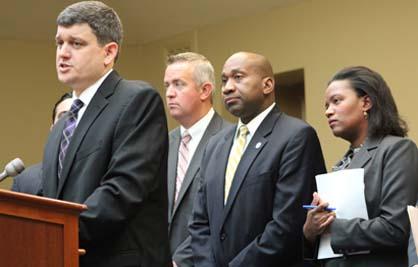October 3, 2012

Councillor John Connolly spoke at a State House press conference this morning. At right, lawmakers Rep. Ed Coppinger, Rep. Russell Holmes and Rep. Linda Dorcena Forry. Photo by Mike Deehan/SHNS
(Updated, Oct. 3, 3:15p.m.) — Future Boston public school students will have the option of going to one of the four schools closest to where they live while current students would be grandfathered to where they attend classes under the existing student assignment process under a plan released this week by City Councillor At-Large John Connolly and five fellow elected officials.
The plan, which does not include zones, comes a week after the city’s school department released five maps in a bid to radically revamp the assignment system, which is currently divided into three zones where students and students get into schools based on a lottery that has frequently drawn complaints from parents.
The elected officials’ plan, announced at a State House press conference yesterday morning, also calls for a network of 16 “magnet” schools, including “Montessori” style schools at the Mattahunt in Mattapan and the Marshall in Dorchester, and a math and science focus at the Young Achievers Pilot School in Mattapan.
Lawmakers at the Wednesday morning press conference, who said their plan includes elements from the other five plans, included Connolly, state Reps. Linda Dorcena Forry, Russell Holmes, Nick Collins, and Ed Coppinger, who are part of the Boston delegation on Beacon Hill. District 6 Councillor Matt O’Malley, who represents Jamaica Plain and West Roxbury, also joined the session.
More coverage: BNN-TV's Neighborhood Network News
Officials Discuss Plan for Boston Student Assignment from Chris Lovett on Vimeo.
The six elected officials penned a letter to Mayor Thomas Menino, Superintendent Carol Johnson, and the 27-member advisory committee that has been weighing the five initial proposals, asking for them to formally include their plan alongside the five department proposals.
“This is not a step that we take lightly or eagerly,” they wrote. “Rather, we hope that it might add to the discussion and help break an impasse in the public dialogue that increasingly frames the current debate as a series of ‘zero-sum choices’ and ‘either/or’ scenarios. We firmly believe that it is possible to give every child a quality school, give every family real choices, and give every family an option to go to school close to home.”
Connolly said the plan aims to increase enrollment, upgrade the quality at all schools, and guarantee more K-8 and citywide options.
Under the elected officials’ plan, parents would also be allowed to form a group and head into an under-selected school in order to “effect change,” Connolly added.
Rep. Forry represents parts of Dorchester and Mattapan, and Holmes parts of Mattapan. Collins hails from South Boston and Coppinger represents West Roxbury and Roslindale. At the press conference, Forry said the plan is the “best route forward” toward comprehensive student assignment reform. “This is not meant to undermine any work that’s been done,” O’Malley added.
Boston Public Schools spokesman Matt Wilder said the department welcomes the elected officials’ plan and the advisory committee is expected to “seriously consider” the proposal, which seeks to adjust of the formula the school district uses to allocate funding to provide additional money for students in need and to steer savings from lower transportation costs to the schools that earned them.
Connolly, who as chair of the Council’s Education Committee has emerged as a tough critic of the school department, said the proposal will save at least $6 million annually in transportation costs. He added that the changes proposed in the plan would bring about better financial planning and “break top-heavy budgeting” at the school department.
The plan also calls for a new building or acquisition of a facility for a school in the downtown area.
School department officials rolled out five plans at the Frederick Pilot Middle School last week that included proposals for 6 zones, 9 zones, 11 zones, 23 zones, and no zones. High schools would remain city-wide, as would the Dudley St. Neighborhood Charter School. Also, new K-8 programs would be available at the Trotter in Dorchester and the Mattahunt in Mattapan.
Under the school plan, siblings would be kept together as would students going to schools within their walk zone. Grandfathering current students would be an option for parents, school officials said this week.
School department officials are gathering input in meetings across the city. Locally, the Mildred Ave. K-8 School will host one such meeting on next Tuesday (Oct. 9) at 6 p.m. Another public hearing is set for the Dever-McCormack School on Mt. Vernon Street next Thursday (Oct. 11) at the same start time.
Another avenue for feedback is a special website set up with the maps and the raw data used to put them together: bostonschoolchoice.org. School officials said last Friday that the site had received 11,000 hits since the previous Monday, and 22,000 hits since the site launched earlier this year.
The coalition of elected officials has set up its own website, complete with a petition: qualitychoiceplan.com.
The advisory committee and the Boston School Committee are considering the proposals. Both are mayorally appointed groups, and the school committee is seeking to pass a final map in the next few months, driven by Mayor Menino’s call for a dramatic overhaul earlier this year.
Topics:


